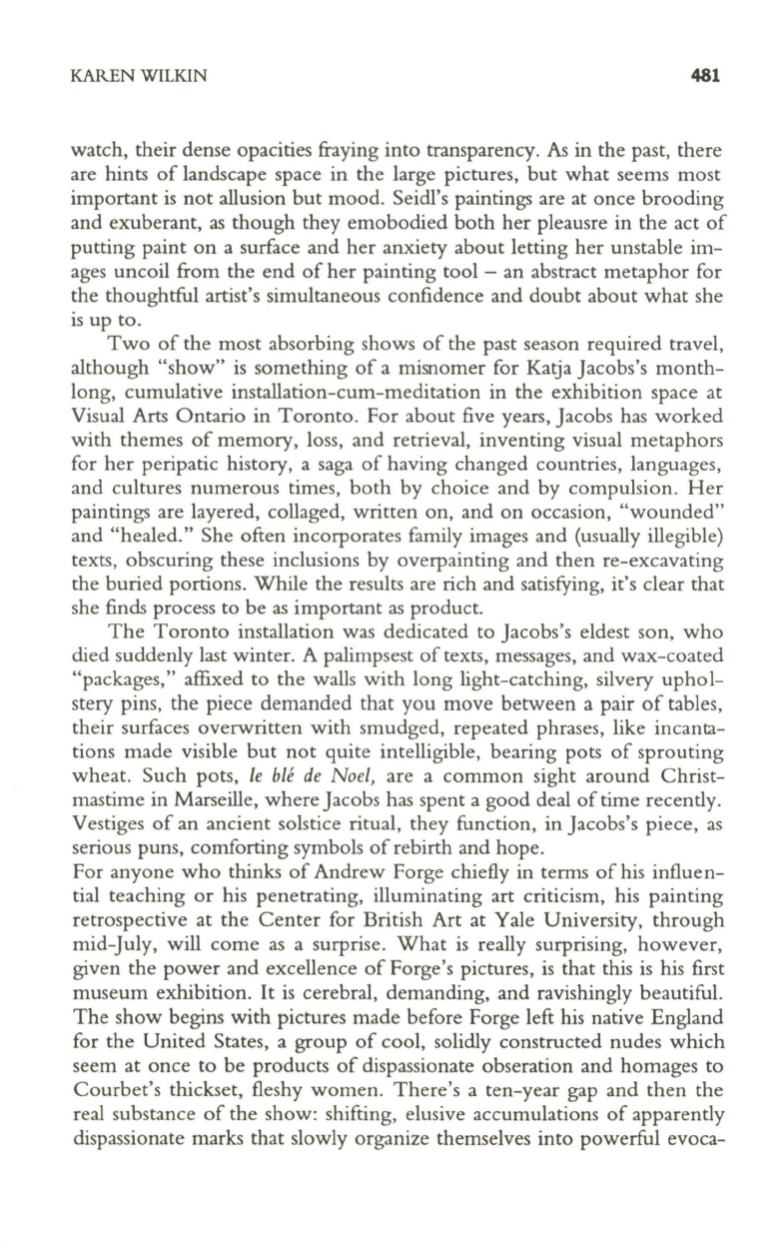
KAREN WILKIN
481
watch, their dense opacities fraying into transparency. As in the past, there
are hints of landscape space in the large pictures, but what seems most
important is not allusion but mood. Seidl's paintings are at once brooding
and exuberant, as though they emobodied both her pleausre in the act of
putting paint on a surface and her anxiety about letting her unstable im–
ages uncoil from the end of her painting tool - an abstract metaphor for
the thoughtful artist's simultaneous confidence and doubt about what she
is up to.
Two of the most absorbing shows of the past season required travel,
although "show" is something of a misnomer for Katja Jacobs's month–
long, cumulative installation-cum-meditation in the exhibition space at
Visual Arts Ontario in Toronto. For about five years, Jacobs has worked
with themes of memory, loss, and retrieval, inventing visual metaphors
for her peripatic history, a saga of having changed countries, languages,
and cultures numerous times, both by choice and by compulsion. Her
paintings are layered, collaged, written on, and on occasion, "wounded"
and "healed." She often incorporates family images and (usually illegible)
texts, obscuring these inclusions by overpainting and then re-excavating
the buried portions. While the results are rich and satisfying, it's clear that
she finds process to be as important as product.
The Toronto installation was dedicated to Jacobs's eldest son, who
died suddenly last winter. A palimpsest of texts, messages, and wax-coated
"packages," affixed to the walls with long light-catching, silvery uphol–
stery pins, the piece demanded that you move between a pair of tables,
their surfaces overwritten with smudged, repeated phrases, like incanta–
tions made visible but not quite intelligible, bearing pots of sprouting
wheat. Such pots,
Ie ble de Noel,
are a common sight around Christ–
mastime in Marseille, where Jacobs has spent a good deal of time recently.
Vestiges of an ancient solstice ritual, they function, in Jacobs's piece, as
serious puns, comforting symbols of rebirth and hope.
For anyone who thinks of Andrew Forge chiefly in tenus of his influen–
tial teaching or his penetrating, illuminating art criticism, his painting
retrospective at the Center for British Art at Yale University, through
mid-July, will come as a surprise. What is really surprising, however,
given the power and excellence of Forge's pictures, is that this is his first
museum exhibition.
It
is cerebral, demanding, and ravishingly beautiful.
The show begins with pictures made before Forge left his native England
for the United States, a group of cool, solidly constructed nudes which
seem at once to be products of dispassionate obseration and homages to
Courbet's thickset, fleshy women. There's a ten-year gap and then the
real substance of the show: shifting, elusive accumulations of apparently
dispassionate marks that slowly organize themselves into powerful evoca-


